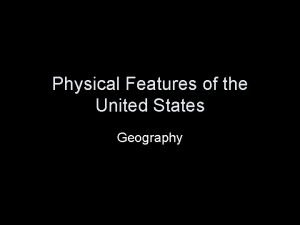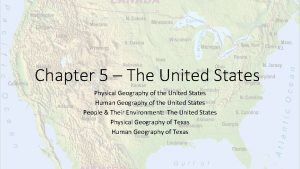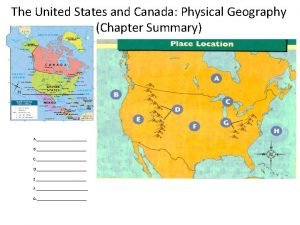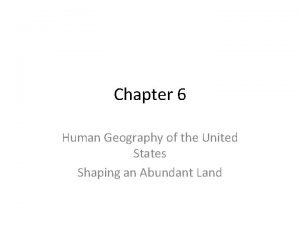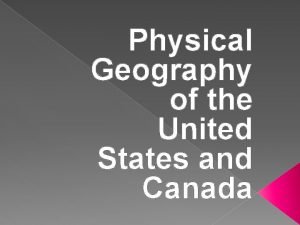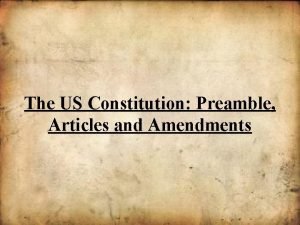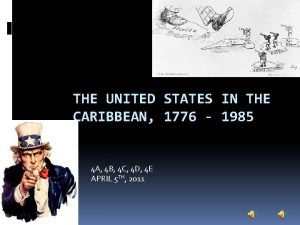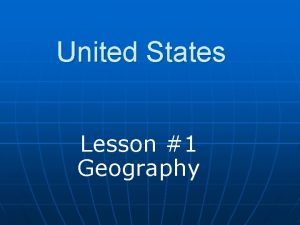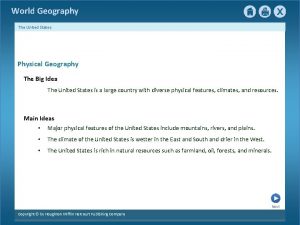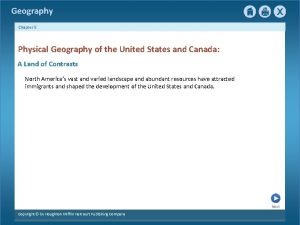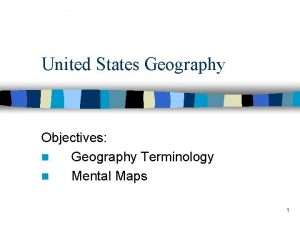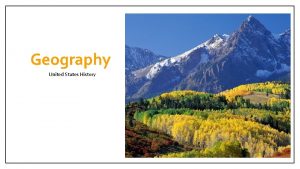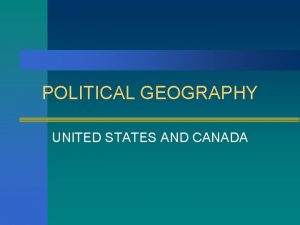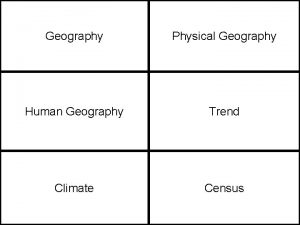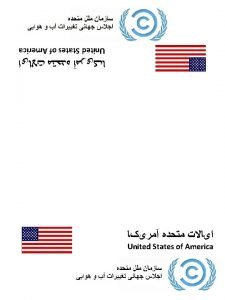Chapter 5 The United States Physical Geography of















- Slides: 15

Chapter 5 – The United States Physical Geography of the United States Human Geography of the United States People & Their Environment: The United States Physical Geography of Texas Human Geography of Texas

Physical Geography of the United States • The U. S. has over 3. 5 million sq. miles. • Third largest country in the world. • Highest point in the U. S. - Mt. Mc. Kinley (Denali), Alaska, 20, 320

Physical Geography of the United States • Tributaries – a small river or stream that feed into a larger river. • Mississippi River – Longest river in the U. S. • • 2, 350 miles Headwaters are in Minnesota 1. 5 miles wide at its mouth Empties into the Gulf of Mexico in Louisiana • Headwaters – the source of a stream or river. • Colorado River & Rio Grande • Rocky Mountains • Divide – the high point or ridge that determines the direction of flow. • Continental Divide – high ridge in the Rocky Mountains. • West flowing rivers flow to the Pacific Ocean • East flowing rivers flow toward Arctic Ocean, Atlantic Ocean, Hudson Bay, and Mississippi River • Fall Line – a boundary in the eastern U. S. where the higher land of the Piedmont drops to the lower Atlantic Coastal Plain.

Physical Geography of the United States • Hurricanes - ocean storms hundreds of miles wide with sustained winds of at least 74 miles per hour that form over warm ocean waters, generally off the coast of west Africa • Saffir-Simpson Scale • Categories 1 -5 • Based on wind speed • 74 mph winds

Before & after Hurricane Ike - Galveston

Physical Geography of the United States • The Great Lakes • Superior, Huron, Ontario, Michigan, Erie (SHOME) • Carved by glaciers • Climates, Biomes, and Resources • Climates range from Tropical to Tundra • Fossil Fuels - a resource formed in the Earth by plant and animal remains over hundreds of millions of years. • Non-renewable • Coal, petroleum, natural gas • Texas & Alaska rank 1 & 2 in U. S. petroleum reserves • U. S. has largest know coal reserves in the world

Human Geography of the United States • Conflicts - a competition or struggle. • Underground Railroad - a network of safe houses in the United States that helped thousands of enslaved people escape to freedom. • Dry farming - a farming method used in dry regions in which crops are grown that rely on the natural precipitation. • Manufacturing Belt - a concentrated region of manufacturing industries in the northeastern and Midwestern United States. • Immigrate - to change residence from a country to begin living permanently in another country. • Sunbelt - a mild climate region in the southern and southwestern portions of the United States. • Megalopolis - a large population concentration made up of several large and many smaller cities, such as the area between Boston and Washington, D. C.

Human Geography of the United States • Post-industrial - economy that emphasizes services and technology rather than industry and manufacturing. • Foreclosure - legal proceeding in which a borrower’s rights to a property are relinquished due to his or her inability to make payments on the loan.

People and Their Environment • Clear cutting – the removal of whole forests when harvesting timber.

People and Their Environment • Acid rain – precipitation carrying large amounts of dissolved acids. • Cars, power plants, & factories release sulfur dioxide & nitrogen oxide that reacts with water vapor. • Kills wildlife • Corrodes buildings • Damages crops • Pollutes soil & water

People and Their Environment • Smog – haze caused by a mixture of atmospheric pollutants. • Car exhaust, carbon monoxide, smoke, etc. • Kills plants • Harm human’s eyes, throats, and lungs

People and Their Environment • Eutrophication - process by which a body of water becomes too rich in dissolved nutrients, leading to plant growth that depletes oxygen in the water. • Red Tide • Acre-foot – the volume of water that will cover an acre in area one foot deep. • ~324, 000 gallons • Serves a family of five for one year • Aqueducts – a system of channels & pipelines used to carry large quantities of water.

Physical Geography of Texas • Natural Regions of Texas • Coastal Plains • • • Largest Region Houston, Corpus Christi, Austin, San Antonio Flat & low-lying on the coast Rolling & hilly inland Plentiful water & fertile soil = good agriculture Natural resources • Pine trees • Grasslands for cattle • Fertile soils • Cotton, rice, veggies, & grains • Petrochemicals – chemicals derived from petroleum or natural gas. • Agribusiness – industries involved in the production, distribution, and marketing of farm products, supplies, and equipment. • South Texas & Rio Grand Valley • Rio Grande – 1270 miles

Physical Geography of Texas • North Central Plains • Escarpments – steep cliffs between higher and lower land. • Higher elevation = colder winter/hotter summer • Great Plains • Dry region • West Central & The Panhandle • Northers - blasts of cold northern air that sweep across the plains, can sometimes drop winter temperatures below freezing. • Llano Basin, Edwards Plateau, & the High Plains • Edwards Aquifer • Palo Duro Canyon Caprock Escarpment

Physical Geography of Texas • Mountains & Basins • Highest & Driest region • Part of the Rocky Mountain System • Davis Mountains • Guadalupe Peak • 2/3 rds of the population live in El Paso • Close economic ties with Mexico, New Mexico, and Arizona • NAFTA – North American Free Trade Agreement • Maquiladoras – factories in Mexico that assemble American-made parts to create finished products…that are sold in the U. S. Guadalupe Peak
 States west of the mississippi
States west of the mississippi United states physical geography
United states physical geography Physical geography of the united states
Physical geography of the united states The physical geography of the united states and canada
The physical geography of the united states and canada Why is the united states called a postindustrial economy
Why is the united states called a postindustrial economy United states and canada physical map
United states and canada physical map Chapter 2 free enterprise in the united states
Chapter 2 free enterprise in the united states Was the united states on the axis powers or allied powers?
Was the united states on the axis powers or allied powers? Mediterranean climate in us
Mediterranean climate in us 36 30 line
36 30 line Us pro soccer
Us pro soccer Marshall case
Marshall case United states student association
United states student association The united states ought to provide a universal basic income
The united states ought to provide a universal basic income Article i of the constitution
Article i of the constitution The united states in the caribbean 1776-1985
The united states in the caribbean 1776-1985

